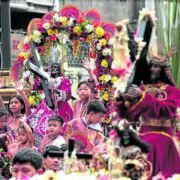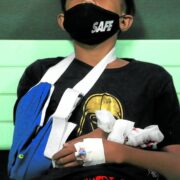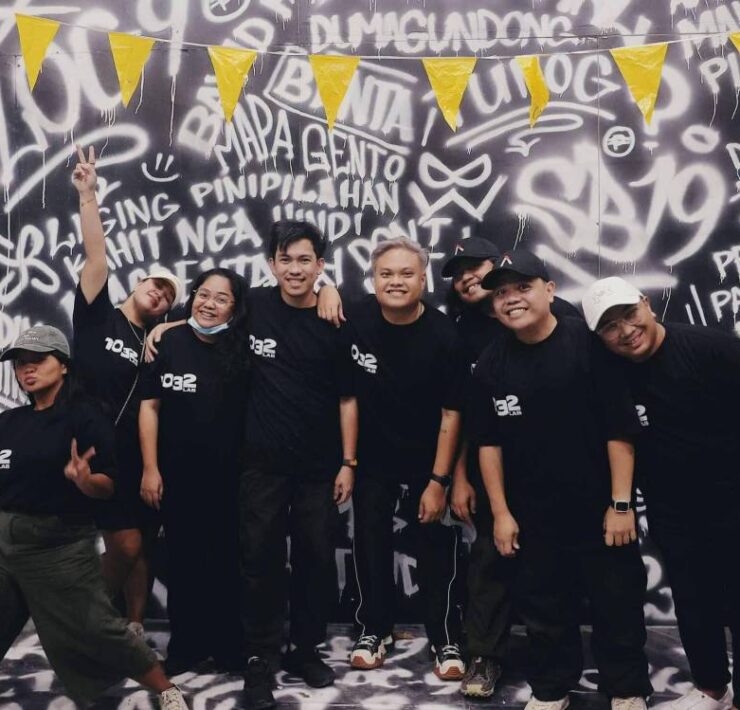Life among chefs and creatives in Siargao
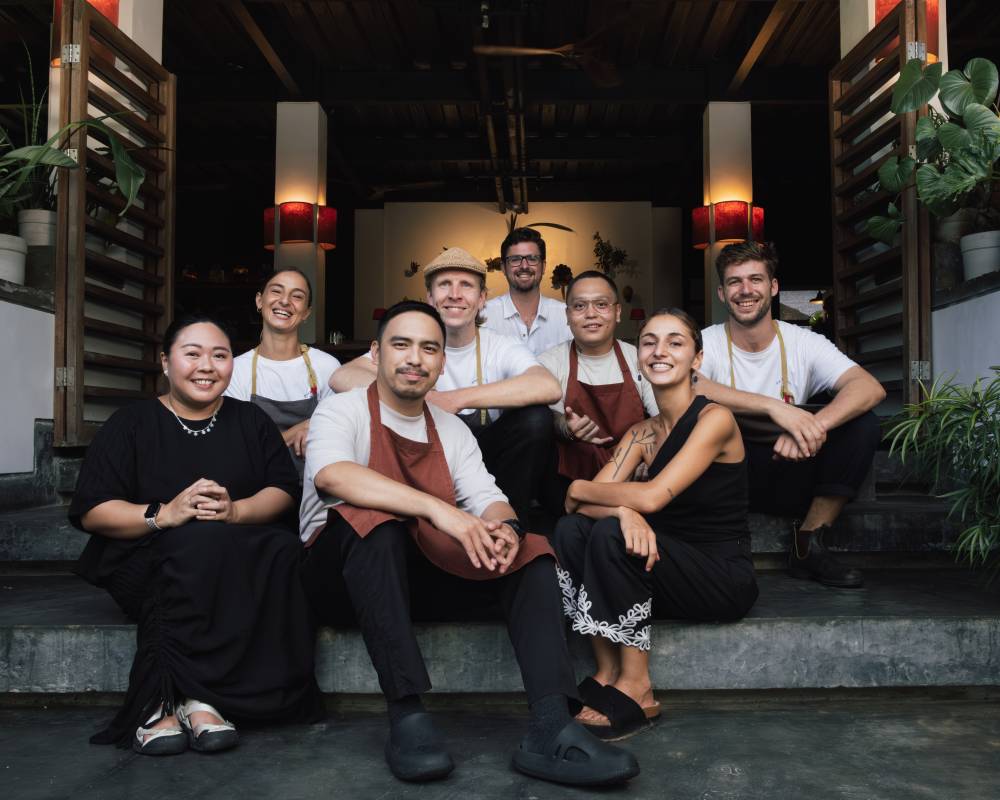
A year ago while scrolling though TikTok, I didn’t think that an iHeartRadio interview of Joe Keery—yes, the guy from “Stranger Things” with the tousled hair and the voice behind the dreamy 2022 song “End of Beginning” that blew up on TikTok two years later—would leave a mark on me.
“I booked ‘Stranger Things’ and left Chicago, and all of a sudden without really realizing it… I was working so hard at this goal to get an acting job where I could quit my job waiting tables,” he explains. “And then I did it. [But] what I didn’t realize was what I was sacrificing, you know, everything that I kind of built in Chicago.”
“That was taken away from me, but I was shoved into this new portion of my life… and I do think everybody has that because life moves in really weird, mysterious ways. You’re never really quite sure when a massive change is right around the corner.”
Little did I know that his words would unexpectedly come back to me—this time in Siargao, where the island’s own “cursed” song is actually a gift for the people who have come but have never gone.
Clueless at the time
On the morning of July 11, I found myself in the passenger seat of a rented car with Roots’ community engagement director Daan Overgaag and a trio of photographers and videographers. We were all on our way to San Isidro to forage for produce that the Roots and Hapag teams will use for their second Kaos Table collaboration—and third overall-—after their successful stint in Rockwell back in February.
“What we’ll see today, the nipa palm, is one of the most aesthetically beautiful and sexy fruits there is,” says Overgaag.
Eyes shining an icy blue with a constant glint of curiosity, the Delft-born anthropologist-by-training has spent most of his early days in Siargao, immersing in the local landscape and putting his (and the rest of the Roots’ team’s) bad habit of “putting everything into our mouths, not knowing if it’s edible or not” to use.
“I’m not born in this environment with these types of products,” he says. It’s understandably expected though. Gather a seasoned group of chefs and creatives in a setting ripe for discovery and before long, that voracious appetite for curiosity will emerge.
While moving to Siargao and opening a restaurant in 2022 has been a big leap for Overgaag and the team, it’s important to note the symbiosis they have with Analyn Dulpina—the co-founder of Lokal Lab, a nongovernmental organization whose vision is to empower the Siargao community through nature-based education, sustainable livelihood opportunities, and intercultural dialogue.
“We built a very dear relationship with her because she’s very important in understanding—not just the culinary side of ingredients, but also the social aspect of how the island works and helping us better understand the context of producers,” says Overgaag, adding that it was Dulpina who introduced them to a lot of the ingredients that they utilize at Roots.
Born and rooted in Siargao all her life, Dulpina later tells me that while Lokal Lab casts a wide net, including journalism programs for kids and marketing, their vision is to make Siargao “sustainable” in the future. “I’m not focused only on foraging but I do regenerative and permaculture design as well as teaching the community how to farm and how to make it a sustainable farm.”
Now, Dulpina and Roots are exploring deeper possibilities in foraging—from Ihaya Farm in Lokal Lab’s Tropical Academy to the San Isidro river, and eventually up the town’s mountain. But it is down by the banks of the river in San Isidro where bigger developments are flowing.
River assured
Later, after arriving at the river, the Roots and Hapag teams, together with family and friends, headed to our assigned boats. Filippo Turrini, Roots’ culinary director, was directing the boarding process, calling the shots like a Siargaonon teen who knows the winding river like the back of his hand.
When everyone climbed onto their canoes and gently pulled away into the quiet waters, we finally got on the last vessel and languorously set sail for the mangroves with the help of a friendly Siarganon paddling at the tail end.
“This is, I think, the most accessible one, especially by road,” says Turrini of the roadside river entry in San Isidro. “In other parts you need to enter a village and walk all the way to the mangroves and the river.”
Apparently, Siargao is home to one of the largest and best mangrove sites in the Philippines—covering 4,871 hectares and winning the Best Mangrove Award at the Para El Mar awards in 2019. But as well as attracting attention for its vastness and beyond the superlatives attached to the site, the mangroves also act as anchors for the community dynamics and the ecosystem. “You have a lot of species of not only plants, but also alimango, crayfish, black clams, and black oysters. You have so much,” says Turrini.
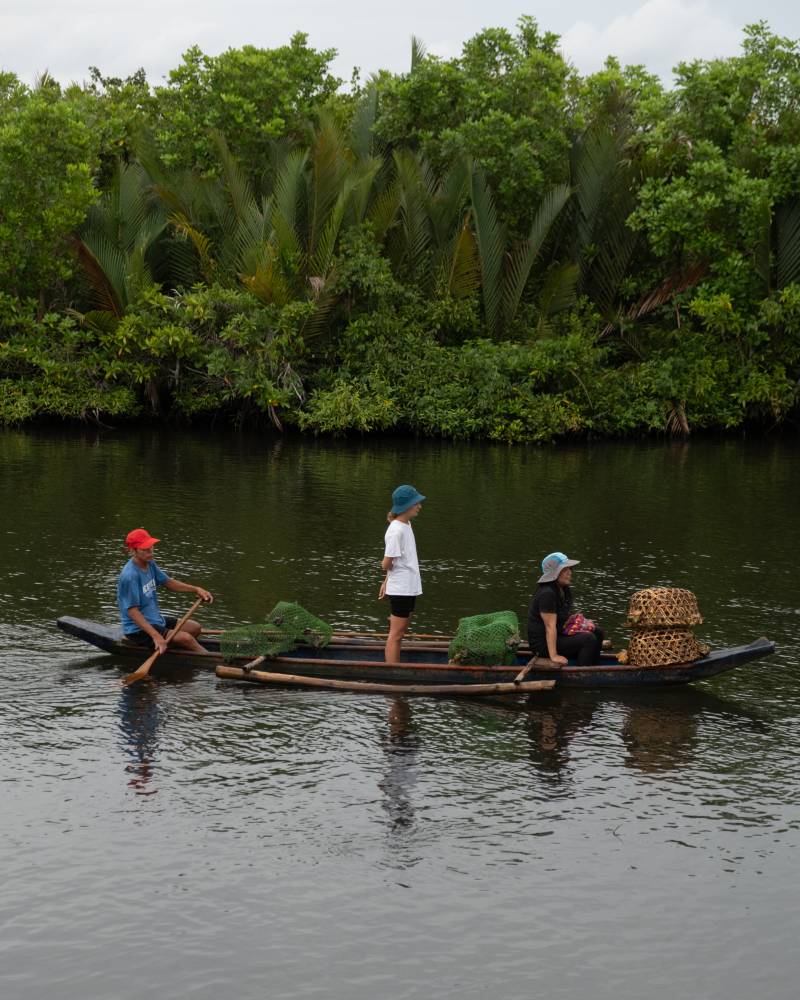
Placidly gliding up the river in what Turrini dubs “fancy” boats that the local government unit invested in to promote the potential of these tours, his initial foray into river foraging was anything but that. “Before, it was proper local boats that are like half the size of this. And you stay like you are under the water. Now, we’re still a bit on top of the waters. It’s a very different feeling.”
Turrini, a 30-year-old from Florence, Italy, is a bursting ball of charm and energy. He loves kansi and the Filipino affinity for acidity. He has lived overseas for many years, leaving his home city when he was 20 years old. But he also has depths that would rival that of Lake Como in Lombardy. Perhaps you can chalk up this vulnerability to his natural tendency to examine himself with candor and perspective.
At one point in his culinary career in Central in Lima, Peru, Turrini realized that the world of Michelin stars, and pressure-filled situations and moments where he had to decide whether to sleep in or stay out on his lone day off was proving to be a concern. Then COVID-19 happened.
“We actually had free time for the first time in a long time. I started reading a book again, sitting down, and not having any worry for a full afternoon,” he shares. “It was something like, ‘Why haven’t I done this? Or when did I do this the last time?’ Because when you’re working six days a week with one day off, you choose: you sleep or you party or whatever. You cannot do everything.”
“That time for us was absolutely like an awakening, let’s say, and we’re like ‘Okay, this is not the life I want to have for the rest of my life. But if you ask me, like, six years ago or 10 years ago, I’d want to have 10 Michelin stars, be the best chef in the world… and now, it’s different. You grow and you have different [versions of] yourself.”
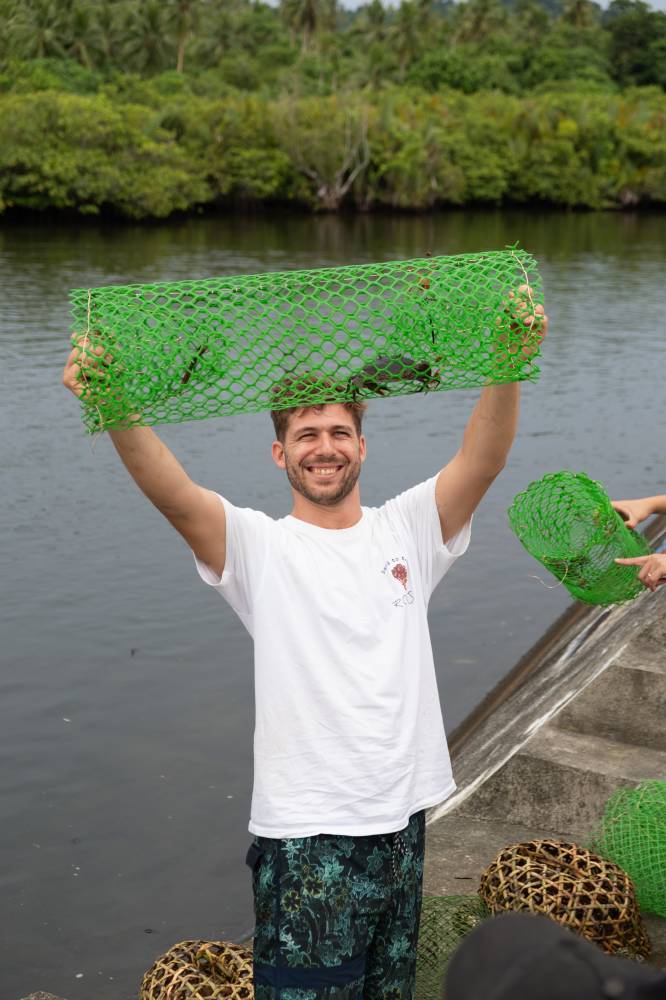
Our conversation brought back memories of that Keery interview and the song he composed about personal changes and accepting his “former life” in Chicago, loving it, but wholeheartedly letting it go for a new, perhaps more purposeful and enriching adventure.
Turrini’s Chicago is in some ways Central in Peru. His time spent there will always be a formative chapter in his, as well as Ines and Marina Castañeda’s and Ricardo Miranda de Sousa’s lives (“Central is probably one of the best places that I not only worked at, but I’ve also eaten at,” he clarifies), but Siargao is where they get to fully embrace their new identities and put down their creative roots.
“We always knew we wanted to do something a bit different than only making food,” says Turrini. “And understanding the local cultures, the local ingredients, the local people was always a base. I think this is coming a lot from our way of growing up from our time in Central to really discover or understand who we really wanted to be as a person.”
Changing tides
Akin to drifting gently on the river, Roots’ search for meaning and ingredients in the mangroves is a metaphor for the new life they’ve built on the island. In both Roots and their new brunch spot Branch by Roots—and even in their research residency program launched in January 2025—Turrini and his co-founders speak about the importance of going with the flow and letting life unfold right before your eyes.
After all, that’s how nature masterfully intended things to be. “If something is in season, it’s in season. If it’s not in season, I don’t think you should cook with it,” says Overgaag.
This is the sound of life in Siargao, too—one that adapts to the changing tides. Here, the rise and fall, the ebb and the flow, the surge and the drop all dictate the island’s goal: to slow down and make room to admire the moment.
“Here, everything goes with the tides,” explains Turrini. In the city, everyone rushes, everyone demands. Not here—everyone is present in the moment, swimming with the tides, and swaying with it. Foraging depends on them; at the Heneral Luna Community Market right off the beach, its operating hours also rely on the rise and fall of the water. This is something that Turrini had to eventually learn and accept.
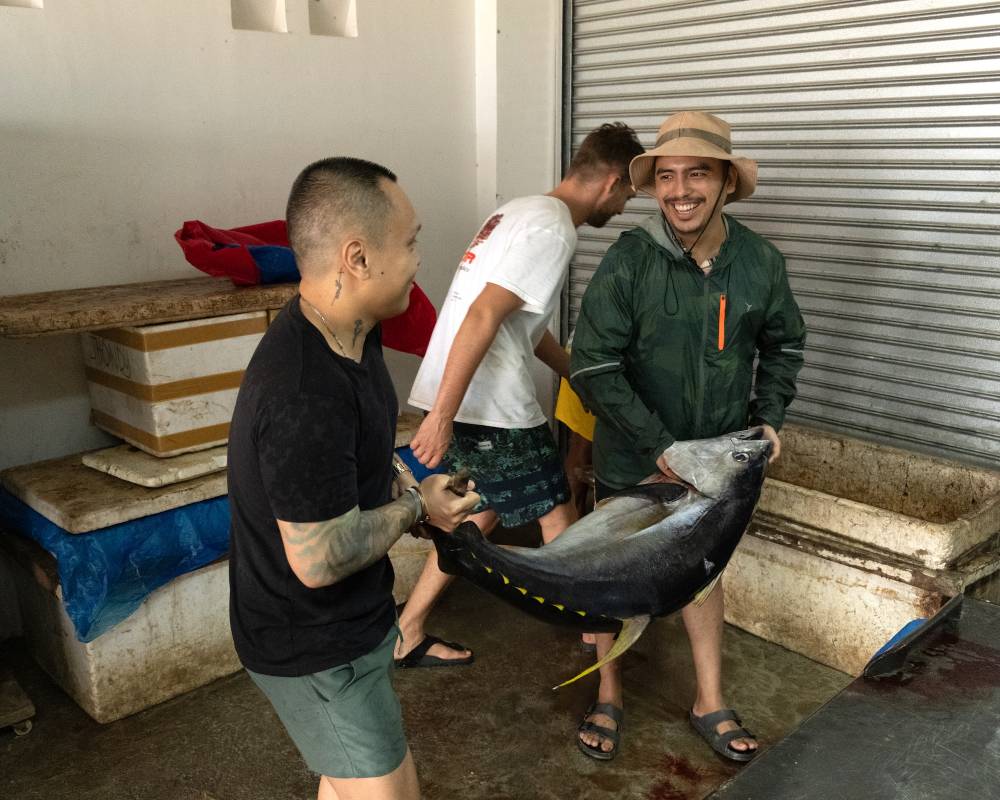
“We went for the first time at 4 a.m. and the market was closed,” he says. “You need to check on the tides. When it’s low tide, there is no water, so the fishermen cannot arrive in the market. There’s no point in opening the market. When it’s mid to high, that’s the best time to go to the market because that’s when a fisherman comes back.”
On our afternoon visit to the market a day before the collaboration, a steady sprinkle rained down upon us, but it didn’t dampen anyone’s spirit. Turrini leads Hapag’s Kevin Navoa, Thirdy Dolatre, and Erin Ganuelas-Recto into the open market—zipping in and out of stalls and saying hi to vendor friends like “Gwapo,” who then invites everyone to a bodega, where the prized catches are stored in large containers.
They pull out a massive tuna, bring it back to the stall, butcher the whole fish, and retrieve a hefty portion of the belly—around 15 kilos—that would be served as kinilaw—complementing Hapag’s agal-agal salad. Elsewhere, the team also purchase nearly five kilos of sail fish to go with the pansit-pansitan, gotu kola, pink begonias, and various other herbs foraged at Ihayas Farm in Del Carmen.

The landscape is on the menu
On the morning of the collaboration, Marina sits in front of the restaurant, gingerly scraping twigs they’ll use for the perky Davao rabbit tsukune course served with cockles from General Luna (that’s surf and turf, Roots-style). Inside the eye of the gathering storm, Ines and Turrini joyously prep, while staff unload freshly caught mantis shrimp from 1.5-liter soda bottles that will serve as the filling for the black tortilla—made with tinigib corn from Bacolod. Navoa, Dolatre, and Ganuelas-Recto, meanwhile, are just as preoccupied with their own preparations as coffee from The Spotted Pig powers sous chefs KC and Jedd.
Just when it seems impossible to view Roots and Hapag—and tasting menus and collaborations in general—in a new light, their second Kaos Table chapter challenges us to see them in a different form. Clearly, adaptation is the theme of the night.
Hapag, fresh from their recently-rolled-out Western Mindanao menu, was still in full control of their instincts as they reimagined and reshaped their takes on siyagul and agal-agal with fish and herbs from local waters and farms. “This decision was made to align with our objective of expanding knowledge and appreciation for the region of Mindanao. We realized that Siargao would be a great place to showcase this as well,” says Navoa about recreating the magic in Siargao.
“I think something we both have in common [with Hapag] is our energy and our love for and pride in Philippine ingredients,” says Marina.
It was another version of adaptation that showed up on the Roots side of the menu. Food rooted in feelings instead of rules—their deepest yet exploration of Filipino cuisine as learners and supporters of the country. Here, Roots sought consistency in creativity amid unfamiliar ground, possibly eclipsing everything they’ve done before. “We allowed ourselves to play with creativity by developing new dishes that we hadn’t offered before,” says Ines. “But we did so without losing our essence: the fusion of our culinary roots with local ingredients, always ensuring that the local ingredient remains the true protagonist of every dish.”
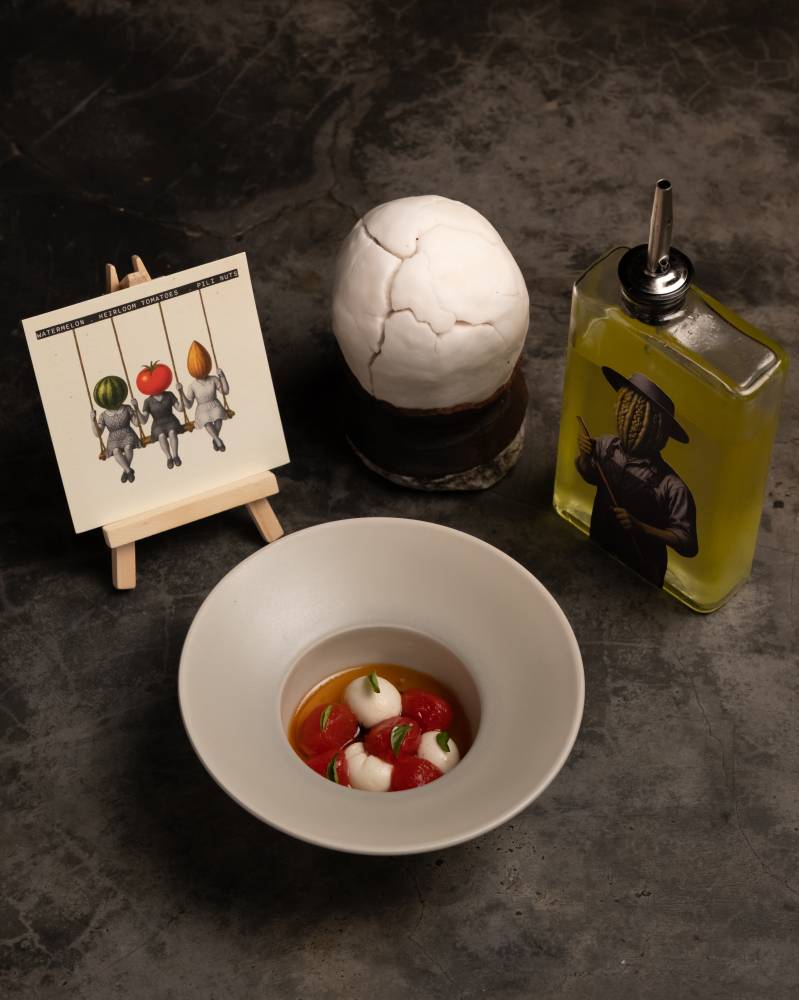
Across the six dishes that tell the narrative of their 10-course collaboration, Roots doesn’t just apply what they have embraced since transplanting into the island, but they also charge ahead with manifestations of their growth (a caprese salad made with pili nuts “mozzarella”), descriptions that detail their understanding of local biodiversity (guyabano fruit and leaves as the protagonist of one dish), and new elements reminding us that they will never forget their roots (of course, there’s taco on the menu)—while simultaneously driving themselves into new directions (a wild honeycomb cake filled three types of natural honey and a sugar cloud marshmallow dessert).
With my time in Siargao slowly drawing to a close, this rare reunion rooted in shared values and Filipino ingredients made me think about three things: First, how far along Roots and Hapag have come in their own personal journeys and the stadium-sized expectations they may have set for themselves; second, the bridge of Djo’s “End of Beginning” where he sings “You take the man out of the city, not the city out the man”; and finally, Turrini’s words as we were cruising along the river.
“We never came here only to open a restaurant, but we really fell in love with this place. And we see that with effort and doing what we believe is correct, we can make a positive impact in the community—not only for the business side, but also for the way this island will develop.”
For a brief shining moment, we get another glimpse of why Roots and Hapag deserve all the merit they have and will continue to receive. As their careers stretch on and find themselves in similar positions, just trust them. Everything will be fine.




